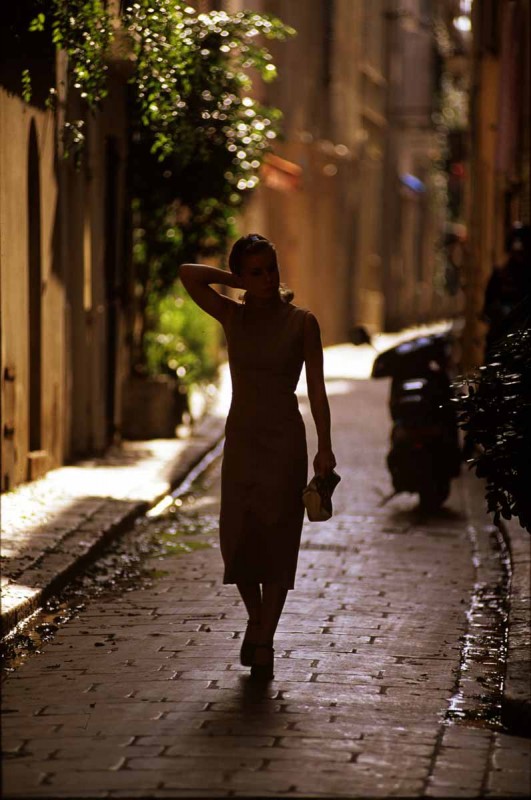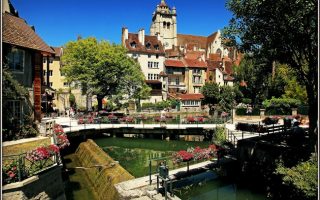Saint-Tropez: All-Season Seacoast

Nestled into a deep hook of land at the base of a short, wide peninsula, Saint-Tropez looks out to the north over its impossibly blue bay-the only north-facing town on the French Mediterranean coast. The odd orientation explains the exceptional light that attracted so many artists, and the famously splendid sunsets. It helps to protect the port from angry seas, but also exposes it to the sometimes ferocious mistral wind that roars down the Rhône Valley and clears the sky to a sharp, cloudless blue.
Inland, the peninsula is cordoned off by the Massif des Maures-a low mountain range covered in dense forests of cork oak and pines. The name, often linked to the Moors, the Saracen invaders of the Middle Ages, in fact comes from the Provençalmaouro, the dark woods. Because of the Massif, Saint-Tropez and its peninsula were long isolated-bypassed by early Roman roads, 19th-century railroads and 20th-century highways. And so for centuries its history was written by the sea.
Legend has it that the Roman centurion and early Christian martyr Torpetius, or Torpès, was beheaded by Nero and his body cast out to sea in a small boat with a dog and a cockerel. The animals were meant to devour the corpse but they did not, and the boat with the miraculously intact body washed ashore near the site that became Saint-Tropez.
But long before that legendary event and during the tumultuous centuries that followed it, the residents of Saint-Tropez-Phoenicians, Greeks, Romans, Genoese-were fishermen and mariners, famed as navigators and boatbuilders, and pivotal in the “maritime caravan” of Mediterranean shipping during the reign of the Ottoman Empire. A strategic bastion, the port was heavily fortified with a citadel and thick stone ramparts built in the 15th and 16th centuries. In the 18th century Pierre-André de Suffren, a Tropézien by adoption and an illustrious officer in the royal navy of Louis XVI, battled the British fleet during the American War of Independence. But by the mid-19th century the great seafaring days were over and Saint-Tropez settled back into its small fishing port for a short nap.
The first late-19th-century travelers to reawaken the sleeping beauty arrived by sea. Author Guy de Maupassant sailed in on the Bel Ami in 1887, and in Sur l’Eau, published the next year, described the coast as a Mediterranean paradise. Sailing on his yacht Olympia in 1892, Post-Impressionist painter Paul Signac was forced into the port by a storm-a scene he later painted in Saint-Tropez, L’Orage (1895), the darkening sky a swirl of indigo, the houses lining the port glowing pink and yellow, the choppy sea blue and violet, and one small boat with a white sail full-blown by the wind.
Signac fell in love with the village and in 1897 moved permanently into a house overlooking Graniers beach-still unspoiled today and easily reached by walking around the sea side of the Citadelle. A funky wooden sign points the way down plank stairs to the sand and a café serving fresh seafood.
In Signac’s wake came his friends: Bonnard, Matisse, Camoin, Manguin, Marquet, Vlaminck, Dufy. Along with Signac’s Storm, their works can be found in the Musée de l’Annonciade, housed in a former 16th-century chapel facing the port-a little jewel of a museum whose windows open onto some of the very scenes depicted in the paintings.
In 1926, novelist Colette moved into a small Provençal house called La Treille Muscate near the bay of Cannebiers, where she spent ten winters of her life and made wine from her own vineyard. “These beautiful cloudless days,” she wrote, “… and these beautiful cold nights. We sleep on the terrace with the stars and the moon whirling overhead.”
Before World War II, movie stars and music hall artists vacationed in Saint-Tropez, sunning on the same Pamplonne Bay beaches that later saw the American landings of 1944. Before retreating, German forces mined the port, causing serious damage, and after the war it was Colette who campaigned to rebuild the rosy ocher and yellow houses along the quay, just as they looked in Signac’s paintings-in fact, much as they have looked since the 15th century. Post-war, the literary lights of Saint Germain des Prés descended-Sartre and de Beauvoir, poet Jacques Prévert, actor Gérard Philippe who lived in nearby Ramatuelle. But it took director Roger Vadim and Brigitte Bardot to put Saint-Tropez on the international celebrity map, when he directed her in the sexily scandalous 1955 film And God Created Woman. Bardot bought her house, La Madrague, near the route de Cannebiers, and Saint-Tropez was launched. “It was a happy mixture of old and young, wealth and class,” noted Vadim later. “A person with no money could live like a millionaire and a millionaire could have fun living like a bohemian.”
Today, in the summer high season, by sea is about the only sensible way to get to town, on ferries from Sainte Maxime, Port Grimaud and Les Issambres, since the roads are blocked for miles around in a monumental traffic jam that lasts from late June to early September. But off-season life is surprisingly calm, making it easy to understand what attracted the crowds in the first place.
At the port, mega-yachts and handsome sailboats still line the quays, but the café terraces are half-empty, and you can plop down for breakfast with ease under the red awning at Sénéquier, the 120-year-old café that started out as a simple pastry shop and wound up as action central for the beautiful people, the jet set and le tout Paris.
There’s a big Provençal market in the Place des Lices every Tuesday and Saturday morning, with fruits, vegetables and all manner of foodstuffs, flowers and fragrances, clothing, shoes, bags, jewelry and a section of antiques and bric-a-brac. There’s good-natured banter all around, and the lilting rhythm of the Provençal accent. Alongside grizzled farmers selling freshly-dug truffles from the upper Var, you might also find a perfect set of vintage Louis Vuitton luggage or spiderweb scarves in next season’s colors-Saint-Tropez is still a fashion weather vane, as the dozens of chic boutiques in the surrounding streets attest. Stop by Sandals Tropéziennes-Atelier Rondini, a family shoemaking firm since 1927 that makes classic Saint-Tropez leather sandals. (For a true fashionista experience, brave the annual Grande Braderie, the last weekend in October, when almost everything in town is out in the street and on sale.)
Once the morning market clears away, Tropéziens play pétanque under the plane trees on the place, just as they do in Charles Camoin’s paintings in the Annonciade. The distant sound of a children’s amusement ride adds a cheerful note, and the aroma of roasting chicken basting in a mélange of olives, peppers and onions wafts from the small rotisserie on the south side of the place. A few doors down is the bakery La Tarte Tropézienne, where you can sample the custard-filled brioche for which it’s named. Opposite, there’s the local favorite restaurant Le Café (formerly Café des Arts) and the trendy Bistrot des Lices.
Even in summer it’s possible to escape the crowds by walking into the old town and the fishermen’s quarter known as La Ponche, havens for year-round residents. Just behind Sénéquier, head through the archway that was once a gate in the old ramparts, now the entrance to the small, mosaic-tiled walk-through fish market. On the other side is the Place aux Herbes, where there’s a small daily morning market. A few flower-decked streets farther on is the church of Notre Dame de l’Assomption with its emblematic rosy-ocher and yellow belfry.
Overlooking the sea, the hotel La Ponche is owned by Simone Duckstein, a true Tropézienne. Her mother and grandmother ran a small fishermen’s bar that evolved into today’s four-star hotel and restaurant. After World War II, Simone reminisces, “people wanted to enjoy themselves, to forget the bad years.” She recalls the filming of And God Created Woman on the tiny beach beneath the hotel, when Bardot used her mother’s bar as a dressing room. She remembers Picasso’s visits too, and points to the spot facing the sea where he liked to sit and drink his pastis. He came to visit a lover, she says, an artist whose studio was just around the corner. As a little girl, Simone often sat and watched the woman paint, but, she says, “when Picasso arrived I was quickly sent away!”
Despite its sophistication, Saint-Tropez is one of the few places on the coast where the rhythm of the sea still plays a small part in daily life. A few traditional lateen-rigged fishing boats, called pointus, are still in use, and a few fishermen still congregate along the quay to mend their nets. Along the stone wall of the breakwater is the green wooden Banc des Mensonges, the Bench of Lies, where it’s said that old-timers sit to recount to one another tales of their past adventures, real or imagined.
The port is the scene of one of the biggest annual events, Les Voiles de Saint-Tropez, a week-long series of regattas that fills the bay with more than 200 sailboats from all over the world-this year scheduled for Sept 26-Oct 4. The other two major annual fêtes are the bravades: religious processions honoring Saint-Tropez on May 16 and 17; and on June 15 a costumed celebration of the victory over 22 Spanish galleys in 1637, complete with deafening volleys of musket fire.
Saint-Tropez has its own beaches-notably Bouillabaisse on the east and Graniers/Cannebiers on the west, past the remarkable old seaside cemetery and the Citadelle with its superb views over the coast and, in its tower keep, the city’s maritime museum.
But the most famous, trendy and chic beaches are on the three-mile stretch of sand lining the bay of Pamplonne, among them Tahiti, La Voile Rouge, Les Palmiers and the elegant Club 55. Here too it’s best to arrive by sea, of course-anchor off the Club 55 pier and call to be picked up by dinghy and whisked in for lunch. Owner Patrice de Colmont cleverly orchestrates the atmosphere by seating a budding film star next to a Hollywood director, or a shipping magnate alongside a Russian oil baron. Large cork slabs filled with crisp fresh vegetables start off a leisurely meal on the beach, in the shade of a canvas awning.
Although they are indelibly associated with Saint-Tropez, the Pamplonne beaches actually belong to Ramatuelle, one of the handful of delightful inland villages and towns that ring Saint Trop’.
Isolated among its vineyards on the flank of a hill, Ramatuelle grew in the form of an escargot, its cobbled streets and arched passageways coiled around the 16th-century church of Notre Dame, whose belfry is a vestige of 14th-century ramparts. It’s thought that the name Ramatuelle might be a remnant of the 10th-century Saracen occupation, derived from rahmatu ‘llah, a kindness of God. On Thursdays and Sundays there’s a market in the Place de l’Ormeau, and although the ormeau(elm) has been replaced by an olive tree, it’s still the place to be for a six o’clock aperitif.
Tiny Gassin is perched on a rocky hilltop surrounded by vineyards, commanding a spectacular view of the seacoast and, on a clear day, the Alps to the east. The Terrasse des Barri, where ramparts once stood, is now planted with exuberant Mediterranean greenery and scattered with restaurant terraces.
Grimaud may be the most entrancing of all the Maures villages, clustered beneath the ruins of an 11th-century château. It’s pure pleasure to wander its winding streets, taking in the lovely Romanesque church, the Gothic arcades of the rue des Templiers, the tiny Musée des Arts et Traditions Populaires and, near the château, the Moulin Saint Roch, a 17th-century windmill restored to working condition.
Down on the coast, Port Grimaud is a miniature Venice built in the mid-1960s, designed by architect François Spoerry, with some 2,000 houses and apartments linked by arched bridges over a maze of canals. There’s much more to explore in the delectable circle around Saint-Tropez: Collobrières and La Croix-Valmer, Cogolin and Plan de la Tour, Sainte-Maxime and the Chartreuse de la Verne. All you need is time.
SAINT-TROPEZ NOTEBOOK
Sandales Tropéziennes – Atelier Rondini 16 rue Georges Clemenceau, Vieux Port, 04.94.97.19.55. website
La Tarte Tropézienne Place des Lices, 04.94.97.04.69. website
Le Café 5 pl des Lices, 04.94.97.44.69. website
Bistrot 3 pl des Lices, 04.94.97.11.33. website
Hôtel de La Ponche 3 rue des Remparts, Port des Pêcheurs, Place Revelin, 04.94.97.02.53. website
Club 55 Plage de Pampelonne, blvd du Général Patch, Ramatuelle, 04.94.55.55.55. website
Originally published in the February 2009 issue of France Today; updated in April 2012
Share to: Facebook Twitter LinkedIn Email



